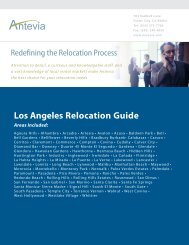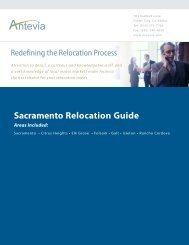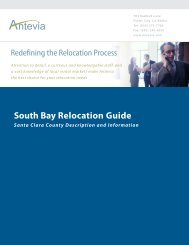San Francisco Relocation Guide - Antevia
San Francisco Relocation Guide - Antevia
San Francisco Relocation Guide - Antevia
You also want an ePaper? Increase the reach of your titles
YUMPU automatically turns print PDFs into web optimized ePapers that Google loves.
Haight-Ashbury, <strong>San</strong> <strong>Francisco</strong>,<br />
California<br />
From Wikipedia, the free encyclopedia<br />
The corner of Haight and Ashbury in 2005<br />
The Haight-Ashbury is a district of <strong>San</strong> <strong>Francisco</strong>, California, USA named after the<br />
intersection of Haight Street and Ashbury Street, commonly known as The Haight or, in<br />
recent years, The Upper Haight. The names of the streets themselves are taken from<br />
Henry Huntly Haight, Governor of California in the 1870's, and one of the city<br />
supervisors of the time, a Mr. Ashbury. Both of them had a hand in the planning of the<br />
neighborhood, and, more importantly, Golden Gate Park at its inception.<br />
The district is famous for its role as a center of the 1960s hippie movement, a post-runner<br />
and closely associated offshoot of the Beat generation who swarmed <strong>San</strong> <strong>Francisco</strong>'s "in"<br />
North Beach neighborhood 2-8 years before the "Summer of Love" in 1967.<br />
History<br />
Before the completion of the Haight Street Cable Railroad in 1883, what is now the<br />
Haight-Ashbury was a collection of isolated farms and acres of sand dunes, most of<br />
which was not graded or developed in any way. The new cable car line, completed in<br />
1883, connected the west end of Golden Gate Park with Market Street and downtown <strong>San</strong><br />
<strong>Francisco</strong>. Shortly afterward, in the 1890s and early part of the 20th century, the Haight-<br />
Ashbury was developed as an upper middle-class residential district. It was one of the<br />
fortunate districts spared in the disastrous fires that followed the catastrophic <strong>San</strong><br />
<strong>Francisco</strong> Earthquake of 1906.<br />
The Haight was hit hard by the Depression, as was much of the rest of the city. Residents<br />
with enough money to spare left the declining and “crowded” neighborhood for greener<br />
pastures such as Forest Hill and St. Francis Wood. During the housing shortage of World<br />
War II, the large single-family Victorians were divided into apartments to house war<br />
workers; others were converted into boarding houses. By the 1950s, the Haight was a<br />
neighborhood in decline. Deferred maintenance took its toll, and the exodus of middleclass<br />
residents to newer suburbs to the south and west continued.







